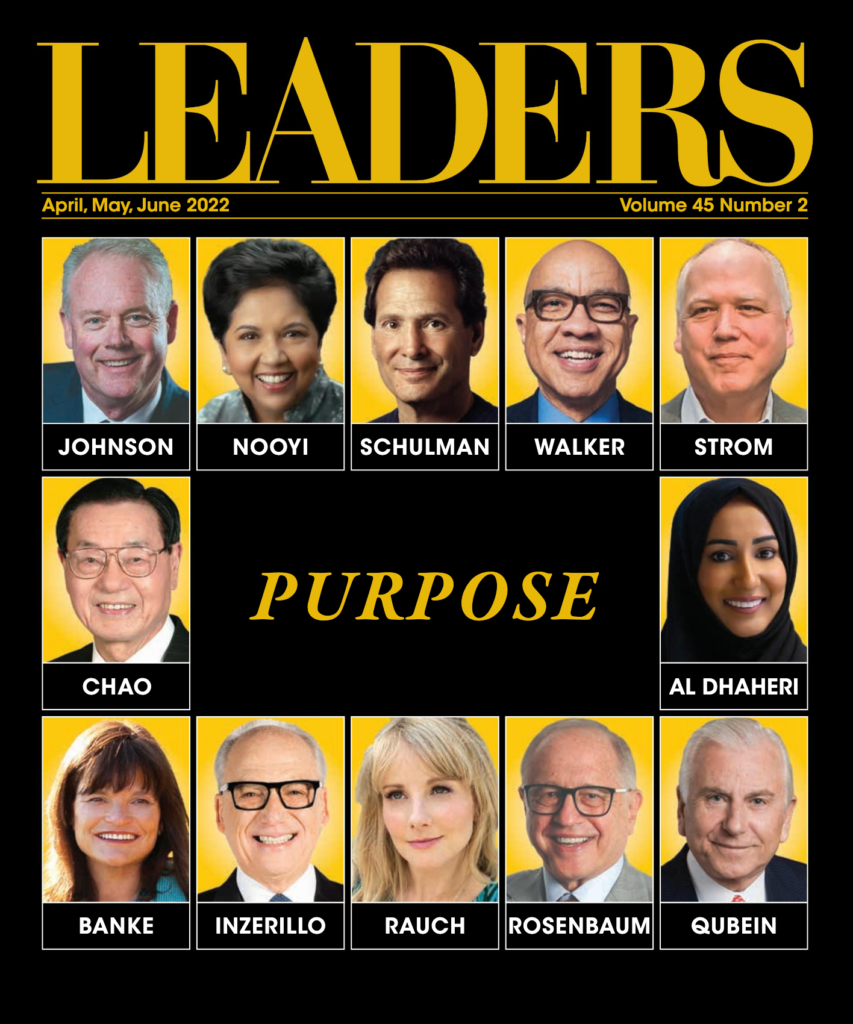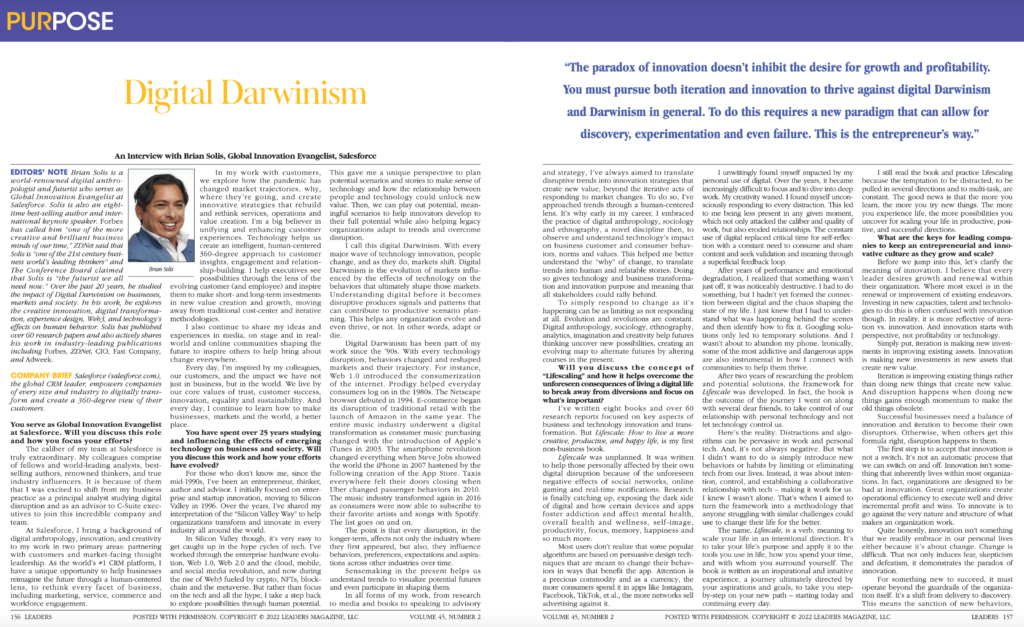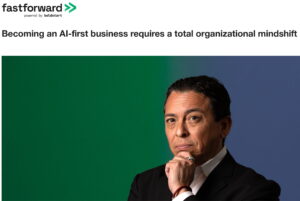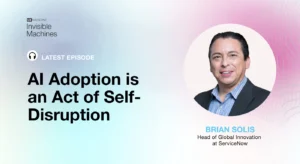
via LEADERS Magazine – April, May, June 2022 – Volume 45 Number 2
ISSUU digital magazine version | Web version | PDF
Digital Darwinism: An Interview with Brian Solis, Global Innovation Evangelist, Salesforce
EDITORS’ NOTE
Brian Solis is a world-renowned digital anthropologist and futurist who serves as Global Innovation Evangelist at Salesforce. Solis is also an eight-time best-selling author and international keynote speaker. Forbes has called him “one of the more creative and brilliant business minds of our time,” ZDNet said that Solis is “one of the 21st century business world’s leading thinkers” and The Conference Board claimed that Solis is “the futurist we all need now.” Over the past 20 years, he studied the impact of Digital Darwinism on businesses, markets and society. In his work, he explores the creative innovation, digital transformation, experience design, Web3, and technology’s effects on human behavior. Solis has published over 60 research papers and also actively shares his work in industry-leading publications including Forbes, ZDNet, CIO, Fast Company, and Adweek.
COMPANY BRIEF
Salesforce (salesforce.com), the global CRM leader, empowers companies of every size and industry to digitally transform and create a 360-degree view of their customers.
You serve as Global Innovation Evangelist at Salesforce. Will you discuss this role and how you focus your efforts?
The caliber of my team at Salesforce is truly extraordinary. My colleagues comprise of fellows and world-leading analysts, best-selling authors, renowned thinkers, and true industry influencers. It is because of them that I was excited to shift from my business practice as a principal analyst studying digital disruption and as an advisor to C-Suite executives to join this incredible company and team.
At Salesforce, I bring a background of digital anthropology, innovation, and creativity to my work in two primary areas: partnering with customers and market-facing thought leadership. As the world’s #1 CRM platform, I have a unique opportunity to help businesses reimagine the future through a human-centered lens, to rethink every facet of business, including marketing, service, commerce and workforce engagement.
In my work with customers, we explore how the pandemic has changed market trajectories, why, where they’re going, and create innovative strategies that rebuild and rethink services, operations and value creation. I’m a big believer in unifying and enhancing customer experiences. Technology helps us create an intelligent, human-centered 360-degree approach to customer insights, engagement and relationship-building. I help executives see possibilities through the lens of the evolving customer (and employee) and inspire them to make short- and long-term investments in new value creation and growth, moving away from traditional cost-center and iterative methodologies.
I also continue to share my ideas and experiences in media, on stage and in real-world and online communities shaping the future to inspire others to help bring about change everywhere.
Every day, I’m inspired by my colleagues, our customers, and the impact we have not just in business, but in the world. We live by our core values of trust, customer success, innovation, equality and sustainability. And every day, I continue to learn how to make businesses, markets and the world, a better place.
“The paradox of innovation doesn’t inhibit the desire for growth and profitability. You must pursue both iteration and innovation to thrive against digital Darwinism and Darwinism in general. To do this requires a new paradigm that can allow for discovery, experimentation and even failure. This is the entrepreneur’s way.”
You have spent over 25 years studying and influencing the effects of emerging technology on business and society. Will you discuss this work and how your efforts have evolved?
For those who don’t know me, since the mid-1990s, I’ve been an entrepreneur, thinker, author and advisor. I initially focused on enterprise and startup innovation, moving to Silicon Valley in 1996. Over the years, I’ve shared my interpretation of the “Silicon Valley Way” to help organizations transform and innovate in every industry all around the world.
In Silicon Valley though, it’s very easy to get caught up in the hype cycles of tech. I’ve worked through the enterprise hardware evolution, Web 1.0, Web 2.0 and the cloud, mobile, and social media revolution, and now during the rise of Web3 fueled by crypto, NFTs, blockchain and the metaverse. But rather than focus on the tech and all the hype, I take a step back to explore possibilities through human potential. This gave me a unique perspective to plan potential scenarios and stories to make sense of technology and how the relationship between people and technology could unlock new value. Then, we can play out potential, meaningful scenarios to help innovators develop to their full potential while also helping legacy organizations adapt to trends and overcome disruption.
I call this digital Darwinism. With every major wave of technology innovation, people change, and as they do, markets shift. Digital Darwinism is the evolution of markets influenced by the effects of technology on the behaviors that ultimately shape those markets. Understanding digital before it becomes disruptive produces signals and patterns that can contribute to productive scenario planning. This helps any organization evolve and even thrive, or not. In other words, adapt or die.
Digital Darwinism has been part of my work since the ’90s. With every technology disruption, behaviors changed and reshaped markets and their trajectory. For instance, Web 1.0 introduced the consumerization of the internet. Prodigy helped everyday consumers log on in the 1980s. The Netscape browser debuted in 1994. E-commerce began its disruption of traditional retail with the launch of Amazon in the same year. The entire music industry underwent a digital transformation as consumer music purchasing changed with the introduction of Apple’s iTunes in 2003. The smartphone revolution changed everything when Steve Jobs showed the world the iPhone in 2007 hastened by the following creation of the App Store. Taxis everywhere felt their doors closing when Uber changed passenger behaviors in 2010. The music industry transformed again in 2016 as consumers were now able to subscribe to their favorite artists and songs with Spotify. The list goes on and on.
The point is that every disruption, in the longer-term, affects not only the industry where they first appeared, but also, they influence behaviors, preferences, expectations and aspirations across other industries over time.
Sensemaking in the present helps us understand trends to visualize potential futures and even participate in shaping them.
In all forms of my work, from research to media and books to speaking to advisory and strategy, I’ve always aimed to translate disruptive trends into innovation strategies that create new value, beyond the iterative acts of responding to market changes. To do so, I’ve approached trends through a human-centered lens. It’s why early in my career, I embraced the practice of digital anthropology, sociology and ethnography, a novel discipline then, to observe and understand technology’s impact on business customer and consumer behaviors, norms and values. This helped me better understand the “why” of change, to translate trends into human and relatable stories. Doing so gives technology and business transformation and innovation purpose and meaning that all stakeholders could rally behind.
To simply respond to change as it’s happening can be as limiting as not responding at all. Evolution and revolutions are constant. Digital anthropology, sociology, ethnography, analytics, imagination and creativity help futures thinking uncover new possibilities, creating an evolving map to alternate futures by altering courses in the present.
“Digital transformation is just that, it’s about using digital to change how organizations operate, create, and evolve, to reimagine business models for a digital world. Digitization buys time. Ultimately however, digital Darwinism defines what it takes to evolve, thrive or fall behind.”
Will you discuss the concept of “Lifescaling” and how it helps overcome the unforeseen consequences of living a digital life to break away from diversions and focus on what’s important?
I’ve written eight books and over 60 research reports focused on key aspects of business and technology innovation and transformation. But Lifescale: How to live a more creative, productive, and happy life, is my first non-business book.
Lifescale was unplanned. It was written to help those personally affected by their own digital disruption because of the unforeseen negative effects of social networks, online gaming and real-time notifications. Research is finally catching up, exposing the dark side of digital and how certain devices and apps foster addiction and affect mental health, overall health and wellness, self-image, productivity, focus, memory, happiness and so much more.
Most users don’t realize that some popular algorithms are based on persuasive design techniques that are meant to change their behaviors in ways that benefit the app. Attention is a precious commodity and as a currency, the more consumers spend it in apps like Instagram, Facebook, TikTok, et al., the more networks sell advertising against it.
I unwittingly found myself impacted by my personal use of digital. Over the years, it became increasingly difficult to focus and to dive into deep work. My creativity waned. I found myself unconsciously responding to every distraction. This led to me being less present in any given moment, which not only attacked the caliber and quality of work, but also eroded relationships. The constant use of digital replaced critical time for self-reflection with a constant need to consume and share content and seek validation and meaning through a superficial feedback loop.
After years of performance and emotional degradation, I realized that something wasn’t just off, it was noticeably destructive. I had to do something, but I hadn’t yet formed the connection between digital and the chaos shaping the state of my life. I just knew that I had to understand what was happening behind the scenes and then identify how to fix it. Googling solutions only led to temporary solutions. And I wasn’t about to abandon my phone. Ironically, some of the most addictive and dangerous apps are also instrumental in how I connect with communities to help them thrive.
After two years of researching the problem and potential solutions, the framework for Lifescale was developed. In fact, the book is the outcome of the journey I went on along with several dear friends, to take control of our relationship with personal technology and not let technology control us.
Here’s the reality. Distractions and algorithms can be pervasive in work and personal tech. And, it’s not always negative. But what I didn’t want to do is simply introduce new behaviors or habits by limiting or eliminating tech from our lives. Instead, it was about intention, control, and establishing a collaborative relationship with tech – making it work for us. I knew I wasn’t alone. That’s when I aimed to turn the framework into a methodology that anyone struggling with similar challenges could use to change their life for the better.
The name, Lifescale, is a verb, meaning to scale your life in an intentional direction. It’s to take your life’s purpose and apply it to the tools you use in life, how you spend your time, and with whom you surround yourself. The book is written as an inspirational and intuitive experience, a journey ultimately directed by your aspirations and goals, to take you step-by-step on your new path – starting today and continuing every day.
I still read the book and practice Lifescaling because the temptation to be distracted, to be pulled in several directions and to multi-task, are constant. The good news is that the more you learn, the more you try new things. The more you experience life, the more possibilities you uncover for scaling your life in productive, positive, and successful directions.
What are the keys for leading companies to keep an entrepreneurial and innovative culture as they grow and scale?
Before we jump into this, let’s clarify the meaning of innovation. I believe that every leader desires growth and renewal within their organization. Where most excel is in the renewal or improvement of existing endeavors. Investing in new capacities, talent and technologies to do this is often confused with innovation though. In reality, it is more reflective of iteration vs. innovation. And innovation starts with perspective, not profitability or technology.
Simply put, iteration is making new investments in improving existing assets. Innovation is making new investments in new assets that create new value.
Iteration is improving existing things rather than doing new things that create new value. And disruption happens when doing new things gains enough momentum to make the old things obsolete.
Successful businesses need a balance of innovation and iteration to become their own disruptors. Otherwise, when others get this formula right, disruption happens to them.
The first step is to accept that innovation is not a switch. It’s not an automatic process that we can switch on and off. Innovation isn’t something that inherently lives within most organizations. In fact, organizations are designed to be bad at innovation. Great organizations create operational efficiency to execute well and drive incremental profit and wins. To innovate is to go against the very nature and structure of what makes an organization work.
Quite honestly, innovation isn’t something that we readily embrace in our personal lives either because it’s about change. Change is difficult. That not only induces fear, skepticism and defeatism, it demonstrates the paradox of innovation.
For something new to succeed, it must operate beyond the guardrails of the organization itself. It’s a shift from delivery to discovery. This means the sanction of new behaviors, measures and support, allowing for ideation and execution to operate away from the core of what makes the company successful today. Said another way, you have to stray from conventions and the comfort zones that protect you to venture into unknown territory with unknown outcomes.
The paradox of innovation doesn’t inhibit the desire for growth and profitability. You must pursue both iteration and innovation to thrive against digital Darwinism and Darwinism in general. To do this requires a new paradigm that can allow for discovery, experimentation and even failure. This is the entrepreneur’s way. Here, failure doesn’t equate to a lack of success. Failure becomes the path to success. It’s testing to learn and learning to grow.
The artist Walter Anderson once said, “It is only when we take chances, when our lives improve. The initial and the most difficult risk that we need to take is to become honest.” To be honest is to be humble, to approach change with a beginner’s mind. Many executives in their day-to-day capacity aren’t representative of their customers or employees. They are not innovators in practice. They report to others who measure performance against renewal and incremental profit. This is why innovation is almost always viewed as a cost center. As a result, companies develop mindsets that safeguard existing perspectives, processes, and norms. By default, they proactively discourage innovation. Because of this, leadership and corporate cultures become rigid, safe and iterative.
What is the cost of not investing in new ventures?
No one achieves greatness because they are convinced there is nothing left to learn or no new ideas to discover. My friends at Gapingvoid Culture Design Group put it this way. Some of the most successful CEOs such as Steve Jobs and Microsoft’s Satya Nadella, among others, all have one thing in common. They each lent their success to well-articulated, inclusive cultures that not only delivered outstanding employee engagement, but more importantly, sustained operational excellence.
Culture is essential to innovation. Innovation is instrumental as a partner to incremental renewal and profitability by complementing the business through the generation of net new revenue. Innovation is directly tied to culture. Nothing new can happen if everything remains the same. Innovation starts with new leadership and innovative leadership creates an innovative corporate culture. And culture shapes not only work, but the values, norms, behaviors and aspirations of the organization. It is a business and human operating system.
Leadership must empower the means for innovation to be successful, from inception to execution. Leaders must foster inclusivity and diversity to create new and different ideas. People must be incentivized and rewarded for championing new possibilities, for failing and succeeding. And, they must operate with autonomy to navigate the art of the possible without the confines of biases, politics, egos, skeptics and detractors or irrelevant measures of progress.
Innovation sits at the intersection of discovery, opportunity and execution. Disrupt the company, not the business model. Augment the business model by creating new value.
Culture doesn’t eat strategy for breakfast. Culture is the strategy. A well-defined, articulated and inclusive culture values understanding people over simply measuring performance. As my friends at Gapingvoid and I emphasize:
- Understand what matters to employees
- Create a shared vision of the new future
- Articulate and socialize new beliefs inside and outside the company
- Enroll and empower employees to bring that vision to life
- Give employees the tools they need to be successful every day
- Incentivize new behaviors and long-term viability
- Reward performance and outcomes, including learned insights from failures
The term Digital Transformation is constantly used today by executives and companies across all industries. What does this term mean to you?
Digital transformation is akin to the relationship between iteration and innovation. Before the pandemic, digital transformation meant many things to different executives. Now in this new world, digital transformation has become synonymous, perhaps unintentionally, with digitization, i.e., iteration.
I once defined digital transformation as the evolving pursuit of innovative and agile business and operational models – fueled by evolving technologies, agile processes, analytics and talent – to create new value and experiences for customers, employees and stakeholders.
With every organization now accelerating digital investments due to the pandemic, companies are more often pursuing digitization versus digital transformation. I’m not sure they understand that they are doing this. But without complementing digitization with digital transformation, companies are missing opportunities that are embedded in every wave of disruption.
The difference is that digitization is applying new technologies to scale, automate, and augment legacy processes. Digital transformation is just that, it’s about using digital to change how organizations operate, create, and evolve, to reimagine business models for a digital world. Digitization buys time. Ultimately however, digital Darwinism defines what it takes to evolve, thrive or fall behind.
Leaders must both iterate and innovate. Leaders must dedicate resources to explore how to create new value in a digital economy. Otherwise, Jeanne Ross, principal research scientist at MIT Sloan School of Management, warned, “The alternative is to try to succeed in a digital economy with a pre-digital value proposition.”
What advice do you offer to young people beginning their careers during this unprecedented time?
In any time of disruption, it’s easy to play it safe. I believe, however, this is a very special time to be alive. This is a very special time to take control of one’s destiny. The world experienced a great resignation, not because people didn’t want to work, but because people did not feel valued or find value in their work. Take this time to explore you. Take this time to understand what drives you. Envision a future that makes you happy and work backwards to your work. Then spend your time learning and acquiring the skills you need. Surround yourself with people who help you on your path and revisit this path often.
You’re faced with a rare CTRL-ALT-DEL moment. While many are seeking a new or next normal, take this time to imagine a new future beyond any normal.
The future can happen to you or because of you. You get to choose.






Leave a Reply